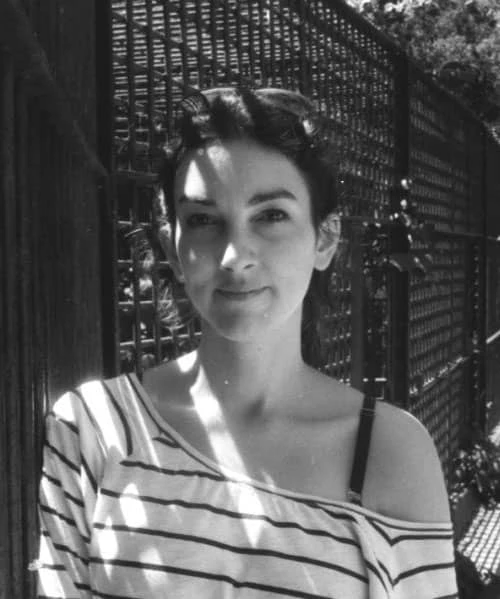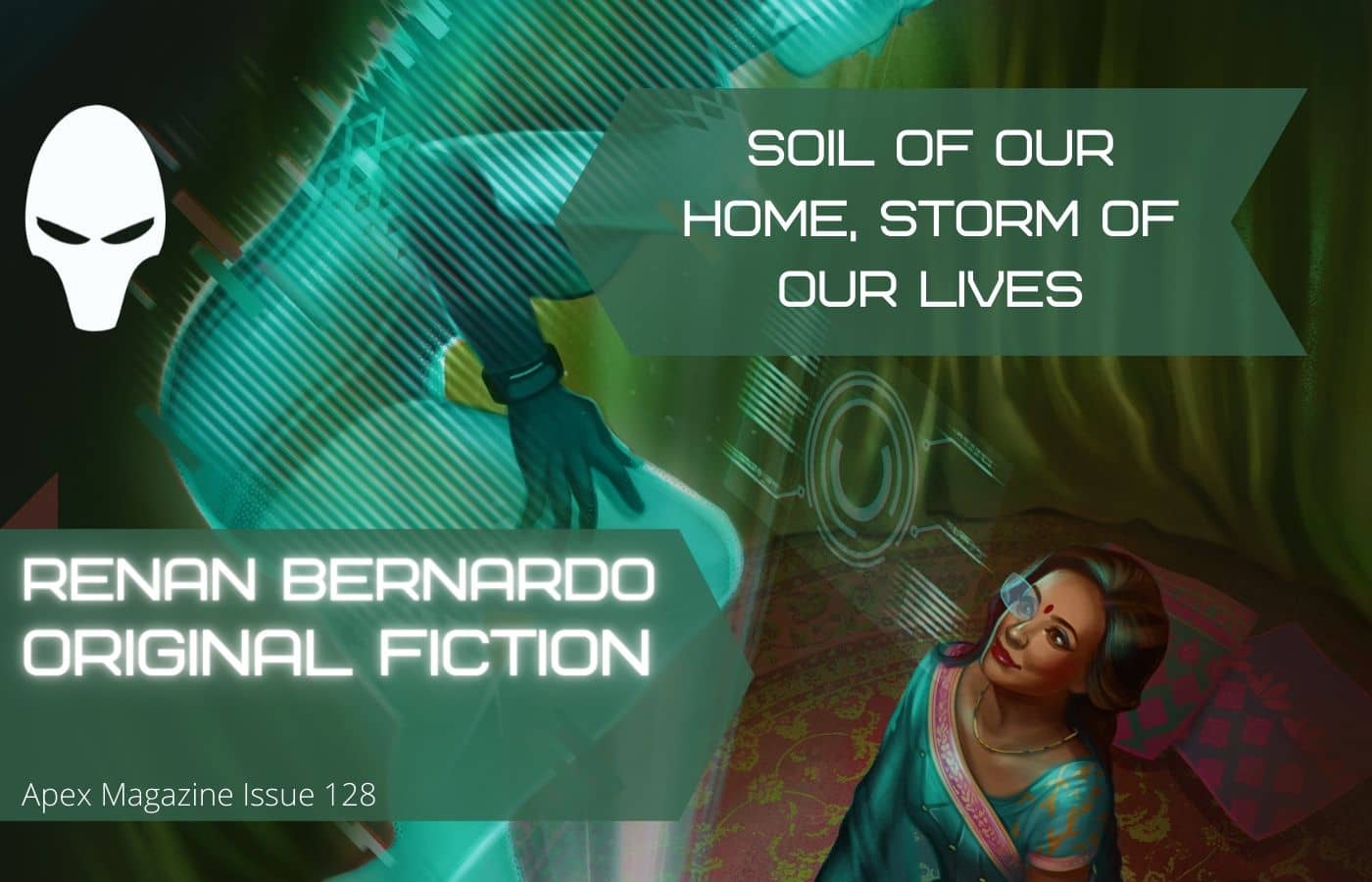
“Soil of Our Home, Storm of Our Hearts” is a climate fiction story that is rich with themes of community and place, hope in the face of powerful destructive forces, and new beginnings—not just on the scale of an individual’s life but for entire communities and the generations to follow.
The story draws from the past and reaches into our future, inviting the reader to think of the sacrifices of those who came before us and the small changes we can make for the people who will come after. It reminds us that we don’t need to go out on a grand quest to change the world out there—change begins at home, and that little seeds planted with compassion can grow into something great.
Even the setting itself is filled with hope—contrasting a world that’s familiar to us (rising sea levels, displacement, oppressive police forces, and forced evacuations) with a vision of a future that feels just out of reach right now but also so possible if we just have the patience to keep working for it. There is a real sense here of time and patience … knowing things can’t change right now but, slowly and inevitably, they will.
Renan Bernardo is a Brazilian writer of science fiction and fantasy, writing in English and Portuguese. His work has been published in English, Portuguese, Italian, and (soon) Chinese. He’s also an SFWA member.
His stories have been published or are forthcoming in Dark Matter Magazine, Simultaneous Times Podcast, and Translunar Travelers Lounge. He also had a story selected for the Imagine 2200 climate fiction contest. In Brazil, his short story “A Norma Aqui de Cima” was a finalist both for the 2020 Odisseia Award and the 2020 Argos Award. In 2021, he published a novelette in Portuguese set in a Rio de Janeiro deeply impacted by climate change.
Board games, history, technology, and rock music are other of his passions. He graduated with a degree in Computing Engineering and works on a project that one day might cast the Earth in a black hole.
He lives in Rio de Janeiro, but you can find him in the virtual world on Twitter @RenanBernardo.
APEX MAGAZINE: Let’s first talk about the brilliant character at the heart of this story, Alzira. She felt so familiar to me: someone who heads to the big city for love, dreams, and risks, but as her mother tells her, “The future begins right here” … at home. It’s not until she returns to her mother’s house that Alzira is able to use her skills—as a programmer, a compassionate rebel, and a gardener—to make the biggest difference to the world. Who or what inspired Alzira as a character, and did you draw from your own life experiences when weaving in this thread of making change from home?
RENAN BERNARDO: Hi, Marissa! Thank you for reading the story and asking those questions. Alzira is mainly two things. First, the everyday Brazilian citizen trying to make sense of their own life and choices, trying to find what it means to belong somewhere while the world around rapidly changes. Second, Alzira is the daughter of someone. I would initially say that I drew the inspiration for Alzira (and her mother) from my own mother, but that’s not completely true. I drew the inspiration partly from my mother, but also from a lot of mothers, aunts, teachers, and workers from Brazil. It’s not rare to see people trying new things, finding new places, new jobs, and moving elsewhere so they can find better opportunities in a society that’s not fair.
Alzira is also what I’d like to see in younger generations: People worried about the community and the wide scope of a city/country/planet, and at the same time, rooted in their own origins and home. We see that a lot in the indigenous populations of Brazil. They’re the ones who most care for the environment without leaving behind their traditions and roots.
I like to see a bit of myself in Alzira too, regarding making changes from one’s own home. My day job is a tiny part of a huge, international network of computers, and I work from my home city. My writing career also involves dealing with a language that isn’t my first one. I like to believe I can make some change in the world, however tiny and shy, even if I choose not to move elsewhere.
AM: I loved that you used an alternating POV structure to give us a past and future perspective of this community and to truly show the way small changes can ripple out through multiple generations. Was this structure something you had in mind when you started writing, or when did you realize that the story needed to have this wider view?
RB: At first the story was going to be about Jota and Célia and how the city where they live came to be. But after a few hundred words, I realized there was much more to it. That’s when I started thinking about these layers of generations. There are actually four generations in the story, even though the focus is only on two of them. And as I wrote it (and edited it), I tried to show how these generations had an effect on that particular society. This is important because it’s a reflection of what one generation means to the next one. Alzira is the daughter of a mother who struggled a lot to see her daughter enrolled in a university while she tried to help the community by preparing food. Célia (Alzira’s granddaughter) is the granddaughter of someone who fought to turn their home into a new place, more livable and fairer than before. So there are these layers of family, each responsible for a fraction of a bigger change, from repurposing a useless golf course to simply cooking some food for your neighbor. Each of these generations has a different fight, a different motivation, different pains and realities to deal with, but it is expected that they don’t have to fight the same fights all over again. Exactly as we, right now, expect that our children and grandchildren won’t need to fight climate change the same way we do. We want them to grow old in a place where they can pick other fights.
AM: The future presented in this story is so hopeful—we glimpse peaceful communities with environmentally integrated technology, where children don’t know the past horrors of police oppression. You created a similar hopeful view of our future in “When It’s Time to Harvest” (published in the Imagine 2200: Climate Fiction for Future Ancestors collection—a fantastic and beautiful story I highly recommend readers seek out!). In both of these pieces, there’s a strong sense of community, of giving back, and of people adapting technology to preserve and honor rather than destroy the environment. What does it mean to you to be able to show a vision of the future in this way?
RB: Thank you for reading “When It’s Time to Harvest”! I’m very happy it got selected for the Imagine 2200 anthology. For me, these things you mentioned (adapting our technology and developing our sense of community) are not only elements of fiction, but crucial to the path we should follow in the decades to come. Both those stories deal with similar themes, meaning that some bad things are unavoidable right now. We’ll have to deal with them, but we, as a community (be it local or global), might face all these changes together and not let them become the end of the world.
With those stories (and others), I also like to show what it means to do things with little to no resources. It’s an inherent aspect of Brazilian society, mainly in the less privileged areas of Brazil. In “Soil of Our Home, Storms of Our Lives,” Alzira doesn’t have much. Her mother had even less. But, perhaps, a plate of food and a garden are enough to do a lot of good and change many lives. It’s similar to what the “sprouses” mean in the story, a seed that fits in your hand but that may grow to become someone’s life and someone’s dream, or just a place to crash without having to worry about the weather.
AM: What is your creative process? When you’re working on a piece, do you have any favorite habits or processes that help your creativity or focus?
RB: My creative process depends on the story, but it usually accompanies ambient or instrumental music of some sort as it helps a lot to focus and shut out all the other things around. Another habit is that I start scratching some ideas in notepad software (I rarely use paper, to the horror of some fellow friends and writers, but I think it comes from my background as a “computer guy”), then, when I think I have something more concrete, I consolidate those ideas into Scrivener and start properly writing the story.
Another habit is that I use to drink iced mate while writing, but I don’t drink coffee. Again, to the horror of some fellow friends and writers.
AM: Who are some of your creative inspirations, and what about their art or ideas makes them meaningful to you?
RB: That is always a hard question because it depends on the type of story I’m writing or the type of idea I’m developing. Regarding climate fiction, I learned a lot from Francesco Verso’s presentations about Solarpunk and the stories he publishes. There are always lots of fresh takes that escape what we usually see in science fiction. I always like to read work from a wide spectrum of worldviews.
Other huge influences are Ursula K. Le Guin and Octavia Butler because they’re two of the most meaningful writers when it comes to devising ways out of what seems a nightmarish world. The hopeful, utopian views of some of their stories are always inspiring.
Not directly related to climate fiction, but there are also many things about Ken Liu’s characters and the relationships he weaves in his stories that I’m deeply fond of.
AM: Can you share anything about what you’re working on next or any upcoming stories we should look out for?
RB: Of course!
My most recent publication is “Premium Resurrection Pack - $99,” published in audio at Simultaneous Times, which is a humorous SF piece about the (un)natural evolution of freemium software and services.
Also, my first fantasy story published in English, “The Whittler,” will be published at some point in the near future in Translunar Travelers Lounge. If you like fairy tales, spriggan-like creatures, and beings who can spawn objects with their voices, it might be your thing! And next year I’ll have a story called “The Dog Star Killer” coming out in Life Beyond Us, an anthology organized by the European Astrobiology Institute. It’s another story set in Rio de Janeiro, but about a massive interstellar cloud approaching Earth.
I’ve recently finished another climate fiction short story set in the same universe as the one published in Imagine 2200 (which also spawned a novelette published in Portuguese by Dame Blanche) and I’ll have other stories coming out in Portuguese too.
AM: I’m so excited to hear that! And thank you so much for your time. This story was a delight to read and think about.
RB: Thank you, Marissa! It was my pleasure to answer these questions.










